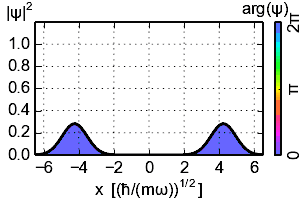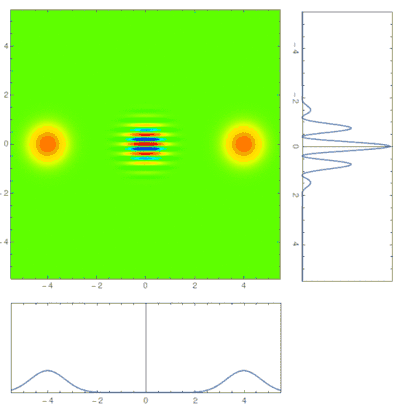Cat state
In quantum computing, the cat state, named after Schrödinger's cat,[1] is a quantum superposition of two macroscopically distinct states. The individual states being superposed could be classical or quantum, but their macroscopicity is an important criterion. A cat state could be of one or more modes or particles, and does not necessarily need entanglement, especially for the single-particle case. This is in contrast to the Greenberger–Horne–Zeilinger state, which by definition consists of multiple distinct particles or modes and their entanglement.
In other quantum mechanics contexts, according to The New York Times for example, physicists view the cat state as composed of two diametrically opposed conditions at the same time,[2] such as the possibilities that a cat be alive and dead at the same time. This is sometimes connected to the many worlds hypothesis by proponents of the many worlds interpretation of quantum mechanics. More prosaically, a cat state might be the possibilities that six atoms be spin up and spin down, as published by a team led by David Wineland at NIST, December 1, 2005.[3] Large cat states have also been experimentally created using photons by a team led by Jian-Wei Pan at University of Science and Technology of China, for instance, four-photon entanglement,[4] five-photon entanglement,[5] six-photon entanglement,[6] eight-photon entanglement,[7] and five-photon ten-qubit cat state.[8] This spin up/down formulation was proposed by David Bohm, who conceived of spin as an observable in a version of thought experiments formulated in the 1935 EPR paradox.[9]
In quantum optics


In quantum optics, a cat state is defined as the coherent superposition of two coherent states with opposite phase:
- ,
where
- ,
and
- ,
are coherent states defined in the number (Fock) basis. Notice that if we add the two states together, the resulting cat state only contains even Fock state terms:
- .
As a result of this property, the above cat state is often referred to as an even cat state. Alternatively, we can define an odd cat state as
- ,
which only contains odd Fock states
- .
Even and odd coherent states were first introduced by Dodonov, Malkin, and Man'ko in 1974.[10]
Linear superposition of coherent states
A simple example of a cat state is a linear superposition of coherent states with opposite phases, when each state has the same weight:[11]
The larger the value of α, the lower the overlap between the two macroscopic classical coherent states exp(-2α2), and the better it approaches an ideal cat state. However, the production of cat states with a large mean photon number (=|α|2) is difficult. A typical way to produce approximate cat states is through photon subtraction from a squeezed vacuum state.[12][13] This method usually is restricted to small values of α, and such states have been referred to as Schrödinger "kitten" states in the literature. Methods have been proposed to produce larger coherent state superpositions through multiphoton subtraction[14] or through ancilla-assisted subtraction.[15]
Coherent state superpositions have been proposed for quantum computing by Sanders.[16]
References
- ↑ John Gribbin (1984), In Search of Schrödinger's Cat, ISBN 0-552-12555-5, 22 February 1985, Transworld Publishers, Ltd, 318 pages.
- ↑ Dennis Overbye, "Quantum Trickery: Testing Einstein's Strangest Theory". New York Times Tuesday (Science Times), December 27, 2005 pages D1,D4.
- ↑ D. Leibfried, E. Knill, S. Seidelin, J. Britton, R.B. Blakestad, J. Chiaverini, D. Hume, W.M. Itano, J.D. Jost, C. Langer, R. Ozeri, R. Reichle, and D.J. Wineland. "Creation of a six atom 'Schrödinger cat' state". Nature. Dec. 1, 2005, 639–642.
- ↑ "Phys. Rev. Lett. 91, 180401 (2003) - Experimental Violation of Local Realism by Four-Photon Greenberger-Horne-Zeilinger Entanglement". Journals.aps.org. 2003-10-28. Retrieved 2016-12-31.
- ↑ "Experimental demonstration of five-photon entanglement and open-destination teleportation". 430. arXiv:quant-ph/0402096. Bibcode:2004Natur.430...54Z. doi:10.1038/nature02643. Retrieved 2016-12-31.
- ↑ "Experimental entanglement of six photons in graph states". Nature.com. Retrieved 2016-12-31.
- ↑ "Observation of eight-photon entanglement". Nature.com. Retrieved 2016-12-31.
- ↑ "Experimental demonstration of a hyper-entangled ten-qubit Schrödinger cat state". Nature.com. Retrieved 2016-12-31.
- ↑ Amir D. Aczel (2001), Entanglement: the unlikely story of how scientists, mathematicians, and philosophers proved Einstein's spookiest theory. ISBN 0-452-28457-0 Penguin: paperback, 284 pages, index.
- ↑ V.V. Dodonov; I.A. Malkin; V.I. Man'ko (15 March 1974). "Even and odd coherent states and excitations of a singular oscillator". Physica. 72: 597–615. Bibcode:1974Phy....72..597D. doi:10.1016/0031-8914(74)90215-8. Retrieved 2016-12-31.
- ↑ Souza, L.A.M.; Nemes, M.C.; Santos, M. França; de Faria, J.G. Peixoto (2008-09-15). "Quantifying the decay of quantum properties in single-mode states". Optics Communications. 281 (18): 4696-4704. arXiv:0710.5930. Bibcode:2008OptCo.281.4696S. doi:10.1016/j.optcom.2008.06.017.
- ↑ Ourjoumtsev, Alexei; Tualle-Brouri, Rosa; Laurat, Julien; Grangier, Philippe (2006-04-07). "Generating Optical Schrödinger Kittens for Quantum Information Processing". Science. 312 (5770): 83–86. Bibcode:2006Sci...312...83O. doi:10.1126/science.1122858. ISSN 0036-8075. PMID 16527930.
- ↑ Wakui, Kentaro; Takahashi, Hiroki; Furusawa, Akira; Sasaki, Masahide (2007-03-19). "Photon subtracted squeezed states generated with periodically poled KTiOPO4". Optics Express. 15 (6): 3568–3574. arXiv:quant-ph/0609153. Bibcode:2007OExpr..15.3568W. doi:10.1364/OE.15.003568. ISSN 1094-4087.
- ↑ Takeoka, Masahiro; Takahashi, Hiroki; Sasaki, Masahide (2008-06-12). "Large-amplitude coherent-state superposition generated by a time-separated two-photon subtraction from a continuous-wave squeezed vacuum". Physical Review A. 77 (6): 062315. arXiv:0804.0464. Bibcode:2008PhRvA..77f2315T. doi:10.1103/PhysRevA.77.062315.
- ↑ Takahashi, Hiroki; Wakui, Kentaro; Suzuki, Shigenari; Takeoka, Masahiro; Hayasaka, Kazuhiro; Furusawa, Akira; Sasaki, Masahide (2008-12-04). "Generation of Large-Amplitude Coherent-State Superposition via Ancilla-Assisted Photon Subtraction". Physical Review Letters. 101 (23): 233605. arXiv:0806.2965. Bibcode:2008PhRvL.101w3605T. doi:10.1103/PhysRevLett.101.233605.
- ↑ Sanders, Barry C. (1992-05-01). "Entangled coherent states". Physical Review A. 45 (9): 6811–6815. Bibcode:1992PhRvA..45.6811S. doi:10.1103/PhysRevA.45.6811.